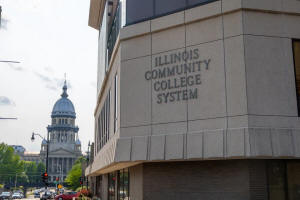Illinois to roll out direct admissions program for most state
universities
[July 01, 2025]
By Andrew Adams
CHICAGO — Illinois students won’t need to fill out applications for most
state universities to be admitted — if they have high enough grades.
With his signature, Gov. JB Pritzker on Monday approved a bill creating
the direct admissions program. Along with it, he approved bills that
implement new state standards for programs offering college credits to
high school students, and new requirements for financial aid application
assistance.
“These bills streamline the application process for college-bound
seniors in Illinois, enhance support for applicants, and open up new
horizons for prospective students,” Pritzker said in a statement.
“Enacting these laws is what all government work should be about —
making life easier for our people.”
Pritzker had said college admissions and higher education accessibility
would be a priority of his during this year’s legislative season, which
ended May 31. But one of his signature initiatives — allowing community
colleges to offer four-year degrees — failed earlier this year.
Direct college admissions
Illinois will implement a direct admissions program so that students
hoping to go to a state school will be automatically admitted — if they
have a high enough grade point average.
“For eligible seniors and community college transfer students, you will
receive offers from the schools that you are admitted to without raising
a finger. That’s huge,” Sen. Christopher Belt, D-Swansea, said. “It
takes away the anxiety, it takes away the angst of that whole process.”
The bill outlining the direct admissions program, House Bill 3522,
passed unanimously in the Senate and with broad bipartisan support in
the House in late May.

The program will begin in the 2027-28 school year, with nine of the
state’s 11 public universities participating:
University of Illinois Springfield
Southern Illinois University
Chicago State University
Eastern Illinois University
Governors State University
Illinois State University
Northeastern Illinois University
Northern Illinois University
Western Illinois University
High school students and community college students hoping to transfer
to a state school must opt-in to the program to receive offers.
Community colleges already admit all students interested in attending
but will still participate in the direct admissions program.
The University of Illinois Urbana-Champaign and University of Illinois
Chicago will not participate in the direct admission program. The state
will, however, provide information about traditional applications to
qualifying students through an “access and outreach campaign.”
The criteria for the direct admissions program and outreach campaign
will be set by individual schools.
“This new, statewide direct admissions program will make a college
degree more accessible for students and will motivate them to continue
in their life-changing college journey by ensuring them a spot at their
community college or at one of the state’s public universities,”
Illinois Board of Higher Education Executive Director Ginger Ostro said
in a Monday statement.
Financial aid application assistance
Two more bills signed by Pritzker on Monday, House Bills 3096 and 3097,
aim to make it easier for students to navigate the financial aid
process.
HB 3096 requires high schools in Illinois to designate at least one
staff member as a point-of-contact for information about the Free
Application for Federal Student Aid, or FAFSA. HB 3097 requires high
schools to offer students time during the school day to fill out FAFSA
forms and to receive assistance in doing so.
The new requirements go into effect in the 2025-26 school year.

[to top of second column]
|

The Illinois Community College Board offices sits blocks away from
the state Capitol. Under a new law, the ICCB and other state
agencies are tasked with improving dual credit programs in the
state. (Capitol News Illinois photo by Andrew Adams)

Information collected through FAFSA is used to determine eligibility for
federal loans. Many schools use FAFSA for their own aid programs, and
the state offers need-based grants based on information submitted
through FAFSA.
“As a father of college students, I just currently went through this fun
exercise with my daughter filling out a FAFSA form,” Sen. Javier
Cervantes, D-Chicago, said. “I’m being a little sarcastic calling it fun
because we had deadlines, we had to make sure we had our documentation
together and it wasn’t easy.”
From the 2010 to 2020 school years, an average of 86% of first-time
students at four-year schools and 78% of first-time students at two-year
schools received federal financial aid, according to data from the U.S.
Department of Education.
Dual credit program
House Bill 2967, another bill approved by Pritzker on Monday, outlines
new requirements for high schools and community colleges offering “dual
credit” programs, through which students earn high school and college
credit for completing a single course.
It requires teachers teaching dual credit classes to have a master’s
degree in the subject they’re teaching or a master’s degree and some
graduate coursework in the subject. It also requires high schools and
community colleges to designate individuals responsible for negotiating
what individual dual credit agreements look like.
“HB 2967 reinforces the vital role that strong, robust partnerships
between community colleges and high schools play in delivering high
quality dual credit programs,” Illinois Community College Board
Executive Director Brian Durham said in a statement. “These programs
help students get a head start on their college education and a path
towards career success.”
The bill also requires schools to consider in-state colleges and
universities when setting up dual credit programs over out-of-state
institutions.
The bill also creates a committee made up of education officials,
representatives from two different statewide teachers’ unions and others
to work on improving dual credit programs’ accessibility and quality, as
updating a template used by school districts to develop dual credit
agreements with community colleges.

Four-year degrees at community college
One key proposal didn’t make the cut this spring — a measure allowing
community colleges to offer bachelor’s degrees. Despite being backed by
Pritzker in his State of the State address earlier this year, it faced
pushback in the General Assembly, which did not pass a bill implementing
the policy.
That proposal drew concerns from some lawmakers who worried it could
undercut programs to attract local students to state universities. In
particular, some lawmakers worried that it could hurt schools like
Northeastern Illinois University and Chicago State University, which
serve largely minority student populations.
But Pritzker on Monday said he would continue working on a proposal to
allow more schools to offer bachelor’s degrees in “very specific, niche
areas” like nursing and advanced manufacturing.
“You sometimes have to work two, four, six years, maybe longer to get
something done,” Pritzker said.
Capitol News Illinois is
a nonprofit, nonpartisan news service that distributes state
government coverage to hundreds of news outlets statewide. It is
funded primarily by the Illinois Press Foundation and the Robert R.
McCormick Foundation. |